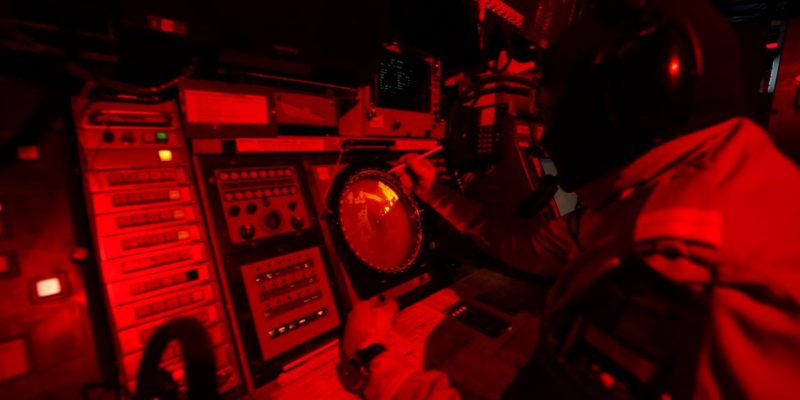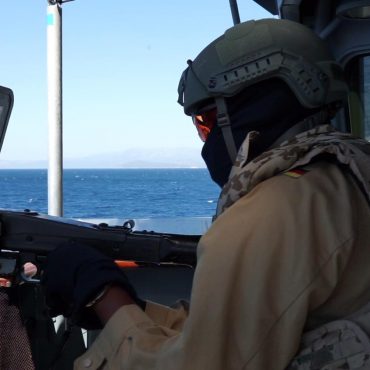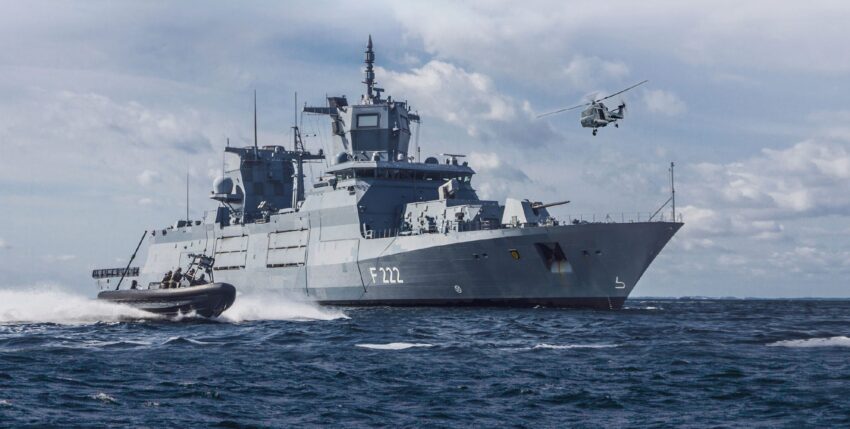Since the early 1990s, the Bundeswehr has been aligned with the changing security policy challenges. As part of this process, the number of naval posts has been reduced from around 30,000 to currently around 15,000, while the number of floating and airborne weapons systems has fallen from around 380 to around 110. At the same time, the intensity of naval operations has increased. It is currently involved in six international missions and mission-equivalent obligations and is supporting the national fight against the pandemic. The navy is also continuing its modernisation process.
In order to do justice to this, the smallest navy of all time is therefore dependent on ensuring the operational readiness of its forces. Recruiting and training the personnel required for this is therefore of strategic importance. With the agenda "Bundeswehr in Führung - Active. Attractive. Different." in 2014, the Bundeswehr set itself the goal of becoming one of the most attractive employers in Germany and establishing itself there. The measures taken to achieve this include new legal regulations, better working conditions, higher pay, the awarding of bonuses and improved social security. In addition, the navy has set up recruitment and development teams in the associations, converted boats to attract new recruits and introduced a seafarer's allowance. Even if it is not yet noticeable everywhere, the navy has been on a personnel growth path ever since. As a result, the manning situation is currently at a fundamentally satisfactory level.
The restriction "in principle" must be made because, despite all initiatives, it has not been possible for years to cover the demand in individual specialisations. This applies in particular to the operations service, which is indispensable for the use of weapons on board. At master and journeyman level, one in five posts cannot be filled. It is becoming increasingly clear that while bonuses, allowances and promotional teams are modern incentives for recruiting personnel, these instruments alone are not enough. This realisation is all the more alarming as the competitive pressure to attract Generation Z increases. The main reasons for this are the shortage of skilled labour and demographic trends. The navy must therefore be quick to gain access to potential applicants.

Structures put to the test
Despite its downsizing, the navy has retained the scope of its operational deployment series and the associated training system. This has become so fragmented and fragmented that the necessary regeneration is noticeably more difficult. Training courses that only take place once or twice a year have already had to be cancelled due to a lack of participants. For the soldiers concerned, this often means long waiting times for specialised training, which impairs the troops' operational capability. As a result, trained personnel from other units, the jumpers, are utilised - and their additional workload is consciously accepted. This rigid commitment is at the expense of flexibility and attractiveness. Conclusion: The Bundeswehr's recruitment organisation is finding it difficult to recruit the personnel it urgently needs and the navy's schools are unable to train a sufficient number of new recruits. The structures must therefore be modernised and provide answers to the following questions:
- How can we move away from this complexity and the associated small numbers so that it is easier to recruit staff?
- What if we were to bring together the training systems of thematically comparable specialisms in a common basic training programme?
- How can we ensure that specialised training is not cancelled and that waiting times are a thing of the past?
- How can we create attractive further training opportunities and make staff deployment more flexible?
Simple and flexible
Answers to these questions will be provided from October 2021 by the new 25 series, the Weapons Operations NCO. The Personnel, Training and Organisation Department of the Naval Command has formed a working group with the operational units, the Naval Operations School and the Federal Office of Personnel Management to restructure the operations service.
The starting point was the conviction of all those involved that there should be no loss of expertise. The sole purpose of the new approach is to recruit, train, develop and deploy more personnel more easily and flexibly. The result is a new series of specialisations, including training courses, that meets the requirements of all operational units. It preserves the existing specialisations and maintains their depth of training. At the same time, it is open to a larger number of civilian entry-level professions, has more state training and further training courses that are also recognised in the civilian sector and facilitates further qualifications. The key features can be summarised as follows:
A series of applications based on the previous activities of surface operations service, underwater operations service, signalling service and electronic warfare. For the first time, it also includes airborne weapon systems in addition to seagoing weapons.

A course that combines the content of the previous four deployment series and starts anew every quarter. Similar to navies of other NATO partners, central parts of the signalling service will only be one bookable module in future. The specialised training course for the Weapons Operations NCO will be divided into two parts. Part A will be attended by the master and journeyman levels together, while Part B is only intended for masters. Specialisation in terms of weapon system and specialist focus (surface combat, underwater combat, electronic warfare) takes place after completing this cross-sectional basic training. The specialist specialisation is not assigned until halfway through the A-grade training, so that talents can be taken into account as well as specialist requirements that have changed in the meantime.
Simplified advertising: Vacancies are only advertised according to place of service and weapon system. The career centres bring the 25 into the navy. However, contrary to previous practice, the specific assignment and specialist focus will only be determined once the person has joined the service.
Combining these four areas of activity in a significantly larger number of applications 25 makes it much easier to promote the Navy's surgical service and to address and advise the target group. In order to support career counselling, media are made available that correspond to the information and digital consumer behaviour of digital natives. These include, for example, video-based job portraits and digital factsheets.
The training system will also benefit from the consolidation. The basic course and the increase in the number of training courses will put an end to small courses as well as waiting times and cancellations. The improved predictability for soldiers, troops and training organisations will increase motivation and satisfaction and contribute to greater operational readiness.
The 25 series also responds to Generation Z's desire for education, varied activities and the opportunity for lifelong learning. Thanks to the joint basic training, every 25 has the opportunity to easily qualify in a further specialist area. This approach is an operational added value, because in future, personnel with a broader range of specialist skills will serve in the Weapons Operations Centre. In conjunction with the gain in training and experience on board, the dependency on "jumpers" is reduced. In addition, replacement options in combat will increase in the event of personnel shortfalls.
Personnel management will also have more room for manoeuvre. In future, it will be easier for them to develop staff, extend temporary contracts, fulfil the desire for regionality or react to changing requirements.
Innovative in marketing
The promotion of this new range of uses follows the approach: "One package - broad marketing - several pick-up points". It was developed parallel to the restructuring in close coordination with the recruitment organisation and draws on innovative approaches.
In concrete terms, this means that the career counselling service is already sounding out the target group and providing initial impetus to interested parties. At the beginning of September, the recruitment organisation is holding the first virtual career fair for the navy called "Mission Marine". In addition to highly informative live sessions, in particular on becoming a non-commissioned officer, or the opportunity to chat with experts, interested parties will have the opportunity to find out about the career opportunities offered by the Navy in a simple and contemporary way on their smartphone. Career counselling will also be more digitalised. For example, it will be possible to arrange online assessment appointments and obtain information using interactive frigates and video-based job portraits.
The "Mission Marine" advertising campaign will also be used to draw attention to the subsequent application weeks in Wilhelmshaven, Kiel and Rostock at the end of September and beginning of October. Interested applicants will have the opportunity to see the navy "live and in colour" and experience a day with event character on the coast. They will be able to complete selected assessment parts and apply for specific positions on site in the organisation. The final assessment follows shortly afterwards at a Bundeswehr career centre. This holistic approach by the Navy and the recruitment organisation synchronises needs assessment, advertising, assessment and scheduling. It will be important to better visualise the navy and seafaring virtually. Ideas for this are already being planned.
Confident about the future
When the first applicants for this new job series are recruited from October 2021 after only around nine months of planning, the working group will have achieved something extraordinary. With the new 25 series of assignments, the non-commissioned officer, the Navy will have a new and attractive job profile. It will make it easier to recruit personnel and finalise the restructuring of training in accordance with the training agenda. It will also make the deployment of personnel more flexible and take better account of the demands of Generation Z and their motivation. If expectations are met, the new job description could well serve as a model for other areas of activity.
Authors: Stephan Küttler and Patrick Pape. Captain Stephan Küttler is group leader in the PAO department of the naval command. Captain Patrick Pape is Head of the Bundeswehr Career Centre Berlin.











One Response
What about job retention for the former 24/27?
Does this no longer apply if you are hired as a 25?
How can undecided applicants be persuaded to join the navy if a day of "event character" is to take place on the coast?
I hope that they do not meet with active seafarers of the Weapons Deployment NCOs.
They will describe the "attractiveness" of seafaring in great detail:
You only come on board partially trained and have to attend a number of courses (battery leader, TSSA, ASG), whereby the courses are mercilessly fully booked and sometimes have over 100 waiting list places. Then you are finally assigned a course, but are not allowed to take part because the ship is going back into action.
Once the ship is at home after the mission, it goes to another ship to prepare for the mission, still without the necessary training courses.
You come back, are finally allowed to do the ASG course and then relieve the guard, who is already putting in 400 hours of overtime.
But now you're working hours yourself, which you then have to reduce, and at the end of August you're told: make sure you get off your holiday. That, in turn, is hardly possible, as you still have 60 days left, but the ship still has 10 weeks of sea voyage on the agenda this year...
Different.than.attractive